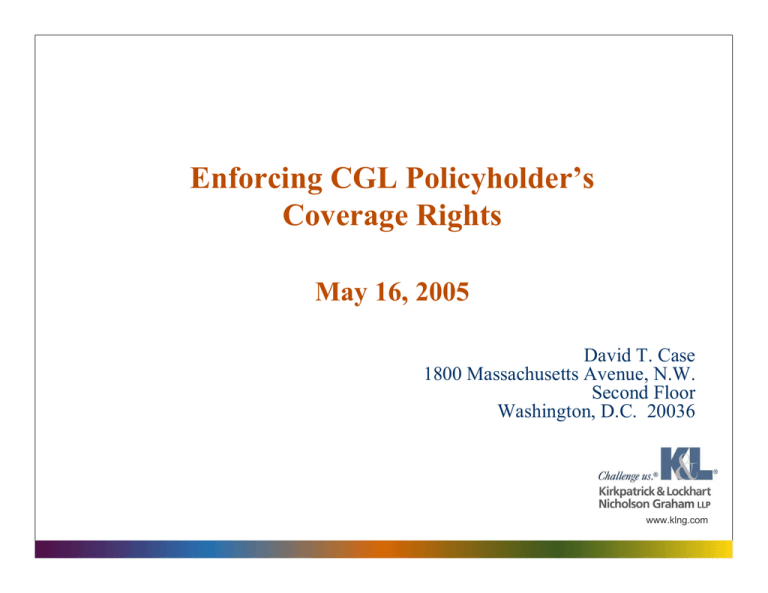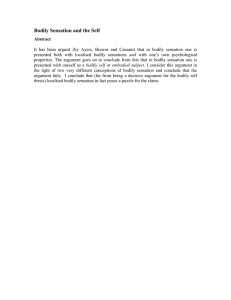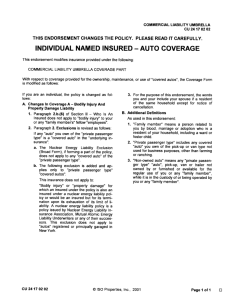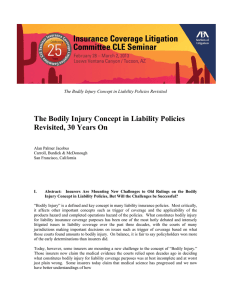Enforcing CGL Policyholder’s Coverage Rights May 16, 2005 David T. Case
advertisement

Enforcing CGL Policyholder’s Coverage Rights May 16, 2005 David T. Case 1800 Massachusetts Avenue, N.W. Second Floor Washington, D.C. 20036 www.klng.com Sources of Risk 1. CERCLA 2. RCRA 3. Clean Water Act 4. State Action 5. Private Plaintiffs (Toxic Tort) 6. Other 2 Sources of Coverage 1. Comprehensive General Liability Insurance 2. First Party Insurance 3. Pollution Liability Insurance 4. Clean Up/Cost Cap Insurance 5. Contractors Pollution Liability Insurance 3 Basic Concepts • Liability Insurance v. Property Insurance • Occurrence Policies v. Claims Made Policies • Coverage Grant • Defenses • Exclusions 4 Scope of Coverage Basic insuring agreement (1973 standard ISO provision): “The Company will pay on behalf of the insured all sums which the insured shall become legally obligated to pay as damages because of (A) bodily injury or (B) property damage to which this insurance applies, caused by an occurrence, and the company shall have the right and duty to defend any suit against the insured seeking damages on account of such bodily injury or property damage, even if any of the allegations of the suit are groundless, false or fraudulent. . . . “ (emphasis added) 5 What Constitutes “Property Damage" Property Damage Is Defined As: • 1. Physical injury to or destruction of tangible property which occurs during the policy period, including the loss of use thereof at any time resulting therefrom, or 2. Loss of use of tangible property which has not been physically injured or destroyed provided such loss of use is caused by an occurrence during the policy period. Facts Relevant to Property Damage 6 What Constitutes “Bodily Injury”? “Bodily injury” is defined as “bodily injury, sickness or disease sustained by any person which occurs during the policy period, including death at any time resulting therefore.” •Facts Relevant to Bodily Injury 7 Trigger Theories • Exposure trigger • Manifestation trigger • Continuous trigger • “Injury-in-Fact” trigger Facts Relevant to Trigger 8 THE “EXPECTED OR INTENDED” DEFENSE 9 The “Expected or Intended” Defense An “occurrence” is an “accident, including continuous or repeated exposure to conditions, which results, during the policy period, in bodily injury or property damage neither expected nor intended from the standpoint of the insured.” (emphasis added) • Objective Standard – Minority Test • Subjective Standard – Majority Test 10 The “Expected or Intended” Defense Fact-Intensive Defense to Coverage • Costly to Prove • Costly to Defend Very Difficult to Prevail on Summary Judgment This Often is “The Issue” at Trial Facts Relevant to Expected or Intended 11 (cont’d) Pollution Exclusion The Pollution Exclusion Coverage is excluded for: Bodily injury or property damage arising out of the discharge, dispersal, release or escape of smoke, vapors, soot, fumes, acids, alkalis, toxic chemicals, liquids or gases, waste materials or other irritants, contaminants or pollutants into or upon land, the atmosphere, or any watercourse or body of water; but this exclusion does not apply if such discharge, dispersal, release or escape is sudden or accidental. (1973 ISO version). 12 Pollution Exclusion (cont’d) • When is the pollution exclusion applicable? • What is the relevant discharge? • What are the relevant facts? 13 What To Do? I. Policyholder A. Provide Notice B. Consult With Counsel II. Counsel A. Policy Analysis B. Facts C. Consult With Experts 14




